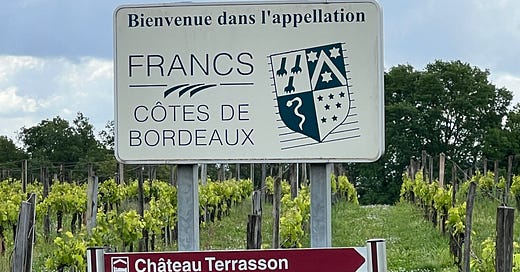Welcome to Francs...
I remember the exact moment it hit me: to keep Southold alive in Texas, we’d have to start making wines for the tasting room and restaurant, not the other way around. It was 2022. The vintage was decent, but the writing was on the wall—we needed to make wines that fit the market, not the vineyard. I fought it. Hard. But eventually, I had to admit that the thing we built was pulling us away from what inspired it in the first place.
We weren’t tending vines anymore. We were managing HR. Running point on logistics. Keeping a restaurant and tasting room alive that could never stop growing. Instead of punchdowns, we were buried in spreadsheets. We weren’t growing wine—we were producing it. And while we loved sharing the space with guests, it started to feel like a beautiful prison of our own making.
We wanted to get back to the spark. But every time we tried to shift course, the machinery pushed back. The so-called invisible hand of the market kept pointing away from the work we wanted to do. It became clear: if we wanted to return to what mattered, we’d have to restart. And that raised harder questions, where? how? were we really willing to blow it all up?
On a lark, we booked a last-minute trip to France. It was part family adventure, part Hail Mary. We didn’t expect answers, but almost as soon as we landed, the current started shifting. People we barely knew opened doors. Opportunities kept surfacing, not because we chased them, but because we said yes when they appeared. We sold our Texas home within three months.
It wasn’t smooth sailing. We missed out on a few properties (stories for another day), and landed in France still unsure where to plant our flag. But in hindsight, that uncertainty was a gift. It gave us time to walk vineyards, ask better questions, and listen. Months later, we stumbled onto a small property in Francs.
The moment we found it, I was pulled back to our first site on Long Island—a broken-down barn full of potential. We’ve always been drawn to the overlooked. But this time was different. We weren’t starting from scratch. We had the approvals. The experience. And the clarity we didn’t know we were missing before.
You’d be forgiven if you’ve never heard of Francs. More French citizens haven’t than have. It’s one of Bordeaux’s smallest appellations, with just 535 hectares under vine. That smallness is part of the draw. You won’t find Francs in grocery store aisles. And if I have anything to say about it, you never will. Wines here aren’t manufactured—they’re made.
Most people hear “Bordeaux” and think blends. Polished. Layered. Grand. But I’ve always been more interested in the singular: one grape, one site, one story. Which is why Cabernet Franc pulls me in.
In Bordeaux, Cab Franc is usually cast as a supporting actor, there to fill in the gaps for Merlot and Cabernet Sauvignon. But when it stands alone, it can be razor-sharp and quietly powerful. Especially here, in Francs, where the slopes, the wind, and the cooler pockets let it stay just shy of ripe. That edge is everything. It’s where brightness, lift, and structure can co-exist. You don’t have to overextract or hide its quirks. You can let it speak. And when you do, it doesn’t need a chorus behind it.
We’re also not ignoring white wines. Historically, this was a region of sweet wines, Sauvignon Blanc and Sémillon made for botrytis and prestige. But empires fall. Climates shift. Tastes evolve. We’re not making dessert wines. We’re making dry, textured whites that reflect this moment in this place.
And the place matters. The limestone here regulates water just enough to stress the vines in the right way. It’s the kind of soil that shaped Bordeaux’s greatest wines, quietly doing its job while the rest of the world fixates on labels.
That’s part of the reason I wrestle with some of my neighbors’ choices. Some of their wines are extraordinary. And I understand why they bottle under Vin de France, to push boundaries, break rules, move freely. But in doing that, they also walk away from place. And for a region this small, identity matters. We’ll use Vin de France when we need to. But when we can, we’ll bottle as Francs. Because we believe in building something, not just sidestepping it. If the rules are outdated, let’s change them. But let’s stay in the room.
What excites me most about Francs is that we didn’t just land here, we arrived carrying every hard-earned lesson from the last decade. We’re not trying to turn this into a spectacle. We’re not chasing scale. We’re trying to stay small and get sharper. To make wines that reflect this place with clarity and care.
And we’re still learning. Understanding a place like this takes time. Rhythm. Listening.
It’s not just about reshaping how people see Francs; it’s about letting Francs show the world exactly what it is… and what it can be.





